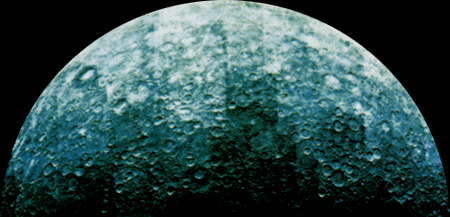

Mercury - is the nearest to the Sun.
Ellusive planet.
|
||||||||||||||||||||
Mercury can be regular seen as an evening star observed only the first two hours after the sunset, or as the morning star - two hours before the sunrise.
Perhaps Mercury was founded by the herdsmenís tribes. But it was difficult to guess the bright morning and evening stars present one luminary. They had several names for this star: Set and Gor (ant. Egipt); Budda and Roginea (ant. Indians) but Greeks named it Apollo and Germes (in Romes mythology Germes the God was called Mercury).
Mercury like the Moon shines by the reflected solar light and has the phases like our satellite. The full Mercury desk is seen, in the moments of the upper connections, when it is hidden in the Sunís beams. In the periods of the greatest brightness Mercury achieves the glitter of the first star value(see the planet movement diagram).
The low reflecting ability of Mercury, determined by the small value albedo (0,07), showed that Mercury has on atmosphere. The proximity to the Sun proves that the nearest to the Sun semisphere of Mercury has a very high temperature. Several radiometric measurements proved it
.As the nearest planet to the Sun Mercury gets more energy from the Sun comparing with the other planets.
The great differences between the "day" and the "night" temperatures are brow 600K to 100K on the opposite parts of the planet. But inside the several tens centimeters there is no temperature fluctuations due to the low thermal conductivity of the soils.The Moon twin.
In 1974 the american spaceship "Mariner-10" flied near Mercury and transmitted to the Earth the image of its surface. The astronomers were shocked. They saw the second Moon! The same surface spot with many craters, some of which has the systems of light beams only dark spots, like the Moon seas were considerably less. The existence of the craters on the celestial bodies was predicted by the soviet astronomers V.V. Phedynsky and K.P. Stanukovitch in 1947.
The evolution and construction of Mercury.
The investigation of photographic images of Mercury surface showed the possible picture of the planet evolution. At the early period of its history Mercury might suffer from the great internal heating after that one or several epoch of the action vulcanization followed.
After finishing the processes of formation the planetís surface was smooth (those parts of an ancient surface are perfectly seen). Further was the period of intensive bombing Mercury by the remains of before planetís swarm (planetozimalies), when the ponds were founded for example Colories (diameter - 1300km) as well as craters like Copernic crater in the Moon.
Mercury is not very large - it is a little bit larger than the Moon, but its density is equal to the Earth's one. Perhaps Mercury has an iron nucleus. And it's weight is about 80% of the planet mass.
Above the Mercury surface there is a rarefied atmosphere, containing helium, hydrogen, carbon dioxide, carbon, oxygen as well as argon and neon.
Because of the Sun Mercury is influenced by the solar wind. The Sunís nearness must arise an electric field above the planet. In the nucleus of the planet small electric current generates.Now the hypothesises about the Mercury construction are verified. But the main property of Mercury is right: from outside it looks like the Moon and from inside - like the Earth.